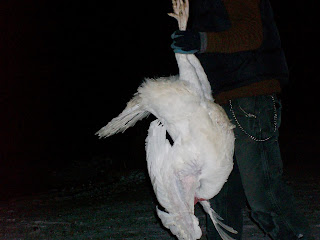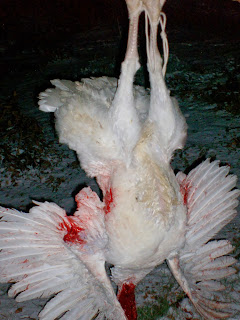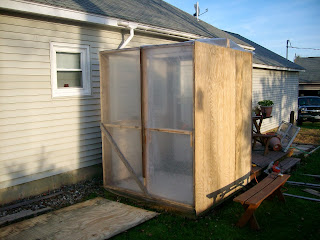WARNING: This post will contain graphic images, so do not read any further if you have any issues with anything related to animal meat preparation.
On November 26, 2013... at some time between 6pm - 7pm (I think)... two turkeys met their fate.
It was a cold, snowy night... dark as squid ink (but our outdoor lights were on so we were fine)... and we knew it was time. Because we waited until the last damned minute to take care of not one, but
two Tom turkeys that we'd acquired from our neighbor up the road.
To be honest, I didn't want to process turkeys at 6 or 7 o'clock at night, but with only one more day until Thanksgiving, and too much to do to get ready for our feast, we had to suck it up and just do it. So we got our butcherin' clothes on, prepared what we needed for slaughter, processing, and packaging... and we got to it.
Now,
because it was dark and cold outside, we decided it would be best to kill the turkeys outside, but to butcher them inside the barn. Had I known what this experience would be like, I would have adamantly insisted on doing everything outdoors.
To begin... did you know that turkeys smell awful??? And I don't mean
after you kill them... They literally smell like a poopy zoo. I had smelled them briefly a few days ago when we first got them, and Ryan opened the door to the mini-garage where we were keeping them until we were ready to process them. I thought they stank
then... but was I in for a surprise.
I had set up the tripod outside in front of the tree that we were going to hang the turkeys from, with the intent of documenting this whole process from start to finish. Well, sorry to disappoint everyone, but I ended up not being able to participate much. Aside from the fact that I didn't feel ready to process the turkeys that night in the first place, once we got the first turkey slaughtered I just couldn't get past the smell.... It started out at the tree... the turkey had just died... and it farted... and it kept farting as Ryan moved it around while un-fastening its legs from the ropes he'd set up.... and it
staaaaaaank. It was that poopy zoo smell, with some other raunchy smell that I couldn't quite identify.
This is the first Tom that we processed. He was alive in this photo, and he was probably farting.
And this was after killing it and he surely was farting here, too.
Some of you may be scoffing at my childish description of the smell, and at the fact that I handled this process in a less-than-stoic manner. Well look.... this was my very first poultry processing experience. For whatever reason, the rabbit we slaughtered did not have this effect on me. In fact, I was rather pleased that I handled it so well and was able to jump right in. The turkeys, however, were simply not what I was expecting (not that I really had many expectations), and there were things about it that caught me off-guard (like the smell) and it just wasn't in the cards for me. That being said, I will gladly try it again, on a bright, sunny day when we can do everything outside in the fresh air. Live and learn.
So Ryan killed the first turkey and we took it into the barn to process. Ryan had set up a counter-top table with our knives and a trashcan to put the guts in. He cut the turkey's head off all the way, then took it outside to submerge it in a tote-full of very hot water. Doing this loosens the feathers so that you can quickly (sort of) and easily remove them.
After the turkey's "bath," Ryan brought it back inside where we cut off the wing tips - which do not really offer any meat and would just add extra work to de-feather - and started plucking. It was really weird resting one hand on the bird's still-warm body and ripping feathers out. I didn't necessarily mind it, but the damn bird still stank. Yes, I will admit, I had hoped that dunking the bird in the hot water may have helped get rid of some of the smell.
It didn't.
Plucking.
While it wasn't taking all that long, it was taking long enough that we didn't feel like doing it any longer (by this time it was nearing 8pm), so we decided to just skin the birds and make a turkey pot pie out of it instead of roasting a whole turkey for Thanksgiving (my pot pies are epic).
Ryan started to gut the turkeys, and Sophia started getting overly-tired, and Maya - though sincerely interested in the whole process - just wanted to go inside and watch a movie. So I happily obliged them and took them inside to settle in for bed. Honestly, I felt really bad because I didn't help with the rest of the first turkey, or the second turkey, but Ryan said he understood and didn't seem to mind doing it himself.
The next day he brought all of the meat in that he had stored in our barn fridge, and holy cow was there a TON!!! Those turkeys had some big breasts. The meat from that alone filled a huge metal mixing bowl we have. We've been eating off of it for three days now, and there's still a bunch left that we're going to freeze. Then there are still turkey legs in the freezer! I used a two legs for some turkey stock, and pulled all of the meat off the bones after it cooked for about 8 hours. It was just like pulled pork.... only turkey.
Gizzard halves, liver, breasts (with heart), legs.
This is another one of those learning experiences I knew we would have at some point along our Farming/Self-Sustaining/Dream-Manifesting journey. Even though I felt like I had failed at first, I realized that I did the best I could this time around, and next time will be better. :)

















































